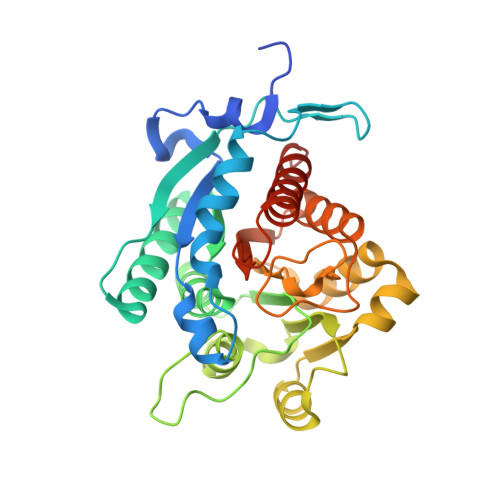Formiminoglutamase from trypanosoma cruzi is an arginase-like manganese metalloenzyme.
Hai, Y., Dugery, R.J., Healy, D., Christianson, D.W.(2013) Biochemistry 52: 9294-9309
- PubMed: 24261485
- DOI: https://doi.org/10.1021/bi401352h
- Primary Citation of Related Structures:
4MXR, 4MYF, 4MYK, 4MYL, 4MYN - PubMed Abstract:
The crystal structure of formiminoglutamase from Trypanosoma cruzi (TcFIGase) is reported at 1.85 Å resolution. Although the structure of this enzyme was previously determined by the Structural Genomics of Pathogenic Protozoa Consortium (PDB accession code 2A0M), this structure was determined at low pH and lacked bound metal ions; accordingly, the protein was simply annotated as "arginase superfamily protein" with undetermined function. We show that reconstitution of this protein with Mn²⁺ confers maximal catalytic activity in the hydrolysis of formiminoglutamate to yield glutamate and formamide, thereby demonstrating that this protein is a metal-dependent formiminoglutamase. Equilibration of TcFIGase crystals with MnCl₂ at higher pH yields a binuclear manganese cluster similar to that observed in arginase, except that the histidine ligand to the Mn²⁺(A) ion of arginase is an asparagine ligand (N114) to the Mn²⁺(A) ion of TcFIGase. The crystal structure of N114H TcFIGase reveals a binuclear manganese cluster essentially identical to that of arginase, but the mutant exhibits a modest 35% loss of catalytic efficiency (k(cat)/K(M)). Interestingly, when TcFIGase is prepared and crystallized in the absence of reducing agents at low pH, a disulfide linkage forms between C35 and C242 in the active site. When reconstituted with Mn²⁺ at higher pH, this oxidized enzyme exhibits a modest 33% loss of catalytic efficiency. Structure determinations of the metal-free and metal-bound forms of oxidized TcFIGase reveal that although disulfide formation constricts the main entrance to the active site, other structural changes open alternative channels to the active site that may help sustain catalytic activity.
Organizational Affiliation:
Roy and Diana Vagelos Laboratories, Department of Chemistry, University of Pennsylvania , Philadelphia, PA 19104-6323, U.S.A.















